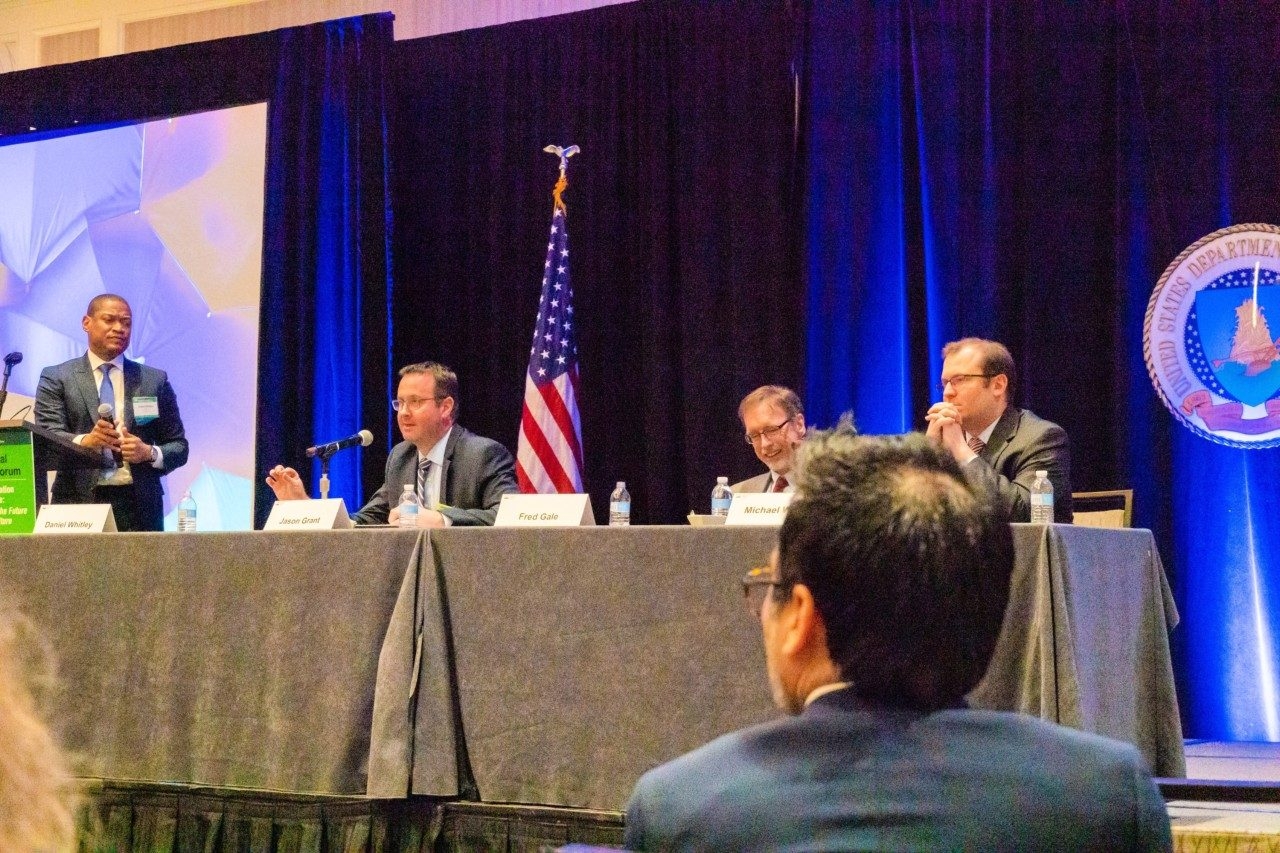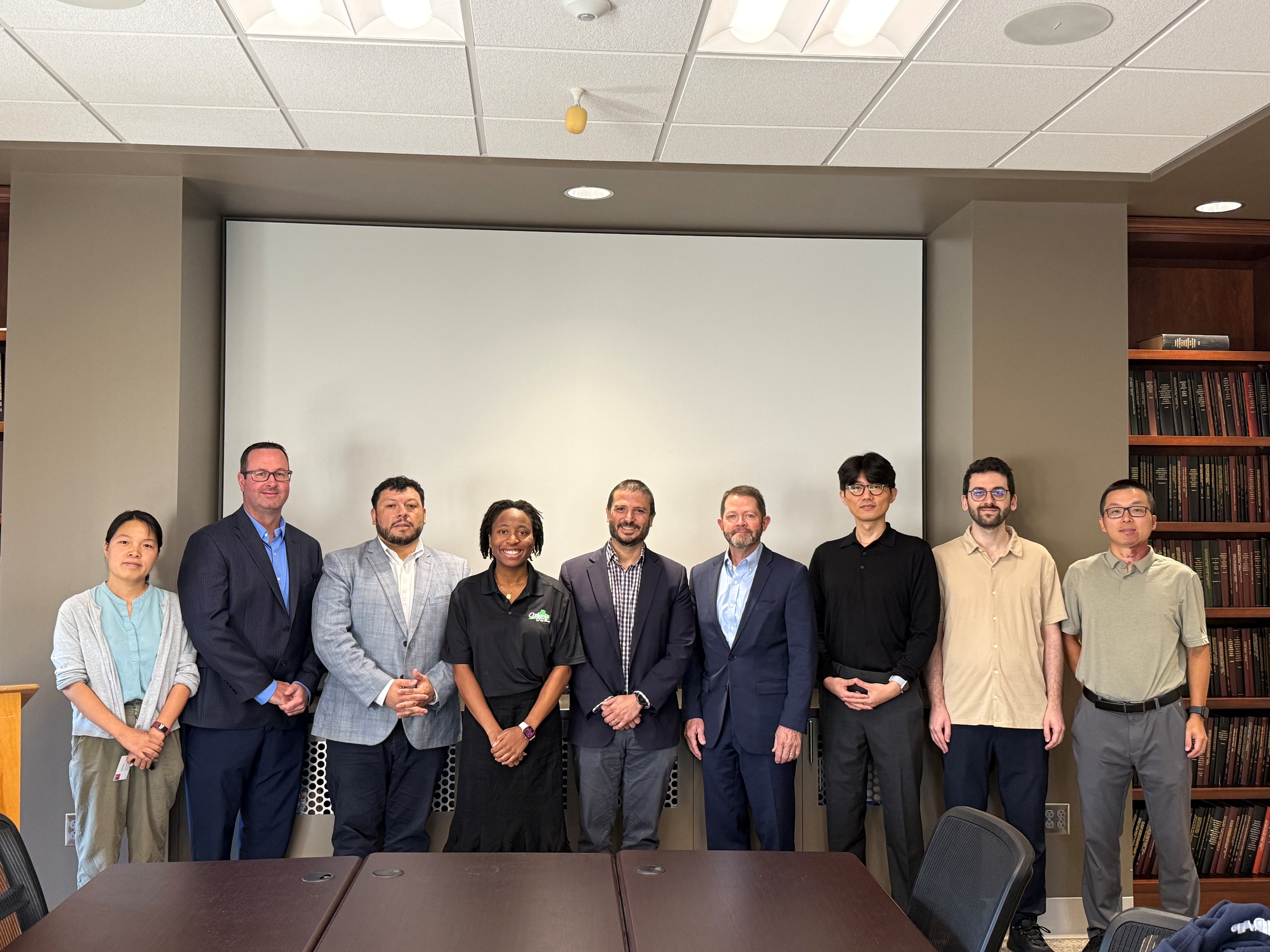News, research, and policy analysis

Jason Grant named researcher of the month for October 2025
Virginia Tech professor helps farmers navigate global trade challenges: The Center for Agricultural Trade is a nationally trusted resource for understanding international agricultural markets in a rapidly changing global marketplace. Read full story >>

Honored guest spotlight
In September 2025, Andres Rodriguez, Agricultural Attaché to the United States and Canada and representatives of the Agricultural Office at the Embassy of Chile in the U.S., met with Tom Thompson and Jason Grant along with faculty and student guests, to discuss agricultural trade.
China’s decision to stop buying soybeans from the United States in February in retaliation for President Donald Trump’s tariffs is set to hit the state’s farmers hard, according to the Virginia Cooperative Extension.
China was the top buyer of U.S. and Virginia soybeans, accounting for 54% of all U.S. soybean exports in 2023-24, according to the American Soybean Association. The next largest buyer during that time frame was the European Union at 11%.
As of September 2024, China had purchased 40% of U.S. soybean exports but has not put in any orders so far this year, the first time that’s happened since official online records were kept dating to 1998, according to The Economist.
Since 2020, Virginia ports have exported an average of $1 billion in soybeans to China, according to Jason Grant, a professor of agriculture and director of the Center for Agricultural Trade at Virginia Tech. If the boycott continues, Grant said, Virginia and other American farmers will see “significant” price discounting on their soybeans. Read more >>
Yunus Emre Karagulle, Charlotte Emlinger, Jason H. Grant
How much do non-tariff measures (NTMs) affect U.S. agricultural exports? While countries maintain a large and diverse set of NTMs to safeguard the health of plants, animals, and humans, policymakers and regulatory bodies may neglect the impact these measures have on international trade. The paper evaluates the impact of two broad types of NTMs important to U.S. food and agricultural exports: sanitary and phytosanitary measures and technical barriers to trade. Read paper >>
Understanding the Dynamics of Global Commodity Prices: A New Approach to Price Persistence and Volatility
The global commodity market is characterized by cycles of low and stable prices that are frequently interrupted by sharp price spikes. These booms are often followed by periods of high and more volatile prices. A key question for economists and market participants is whether the current high prices of commodities will last, and if so, for how long. Understanding the forces behind these fluctuations is essential for policymakers, producers, and consumers. Read more >>
The Virginia Agricultural Trade Conference | April 22, 2025
The event featured an exceptional lineup of distinguished speakers who discussed the challenges and opportunities in global agricultural and forestry exports. View conference photo album | View reception photo album
Tariffs are in the spotlight again as President Donald Trump proposes additional tariffs on goods from Canada, China, and Mexico. But what does that really mean for consumers, markets, and international relations? Two Virginia Tech professors, Dimitris Tsarouhas and Jason Grant, dive deep into the topic, breaking down the pros and cons of tariffs and how they could impact the economy. Tsarouhas, a visiting associate professor and expert on international affairs, and Grant, a professor and agricultural economist, give their insights on this crucial issue. Click to read Q&A.
This Farm Foundation Issue Report, written by Jason Grant and Nicolas Legrand Virginia Tech Department of Agricultural and Applied Economics, evaluates the economic implications of Environmental and Climate Change Canada’s proposed plastic packaging restrictions for retail prices and per capita fresh fruit and vegetable availability for Canadian consumers under alternative import supply reduction scenarios. >> The complete report can be accessed here.
Lead guest editors Jason Grant and Shawn Arita along with co-guest editor Wyatt Thompson's analysis of Choices-themed issue >> Turmoil in Global Food, Agricultural, and Input Markets: Implications of Russia’s Invasion of Ukraine.
This issue provides a timely review and initial assessment of the impact of Russia’s invasion of Ukraine on key agricultural commodity markets and trade, as well as implications for a potential conflict of longer duration. The results can be used to inform business planning, public policy, and international efforts to alleviate the food security consequences of the war.
A related article by Xi He, AAEC assistant professor. >> Read full article
In 2022, China’s total food and agricultural imports reached a record $218 billion, compared to its agricultural exports of $70 billion making China the largest net importer of food and agricultural products by a considerable margin. China’s 2022 import levels follow on the footsteps of retaliatory tariff increases in 2018 and 2019, the Economic and Trade Agreement between the United States of America and the People’s Republic of China (Phase One that entered into force on February 14, 2020), and the Covid-19 pandemic. While the two-year Phase One agreement (2020-2021) fell short of the purchase commitments China agreed to, its agricultural imports from the U.S. soared to record levels in 2022, and the share of China’s agricultural imports sourced from the U.S. has recovered to levels at or near the pre-trade war era. Read more >>
- Balagtas, J.V., J. Cooper, and M.A. Marchant, editors, 2021. “Agricultural Market Response to COVID-19," Choices, Quarter 3. Available online
- May 2020 - COVID-19 & Agricultural Exports under the U.S.-China Trade Deal
- May 2020 - Resilience test of the North American food system
- November 2020 - Has Covid19 Caused a Great Trade Collapse? An Initial Ex Post Assessment
- August 2018 - Trade Elasticities and Trade Disputes: New Evidence from Tariffs and Relative Preference Margins
- July 2018 - Hidden Trade Costs? Maximum Residue Limits and US Exports of Fresh Fruits and Vegetables
- May 2018 - The Role of State Owned and Private Enterprises in China's Agricultural Imports
- Marchant, Mary A., editor. 2017. “U.S. Commodity Markets Respond to Changes in China's Ag Policies” Theme Issue, Choices. Quarter 2. Available online
- October 2017 - Evaluating the Trade Impacts of Bovine Spongiform Ecephalopathy (BSE) Using Historical Simulations
- David Orden publishes an article on agrifood markets one year into COVID-19 pandemic
- Jason Grant shares insights into potential changes to trade relationships as a result of COVID-19
- Jason Grant shares at USDA Ag Outlook Forum
- Choices Special Issue - One Year Review of U.S.-China trade dispute
- David Orden participates in the Consumer Federation of America Food Policy Conference panel "Casualties of Trade Wars"
- Research Report on Trade Elasticities and Trade Disputes
- Choices Special Issue on U.S.-China Trade - Mary Marchant, co-editor & contributing author. This theme issue was awarded the 2019 Agricultural and Applied Economics Association (AAEA) Quality of Communication Award.
-
Article Item
 Q&A: Experts break down potential tariff impacts , article Date: February 2025 -
Q&A: Experts break down potential tariff impacts , article Date: February 2025 - -
Article Item
-
Article Item
 Jason Grant named W.G. Wysor Professor of Agriculture , article Date: May 2022 -
Jason Grant named W.G. Wysor Professor of Agriculture , article Date: May 2022 - -
Article Item
Page 1 of 2 | 8 Results






